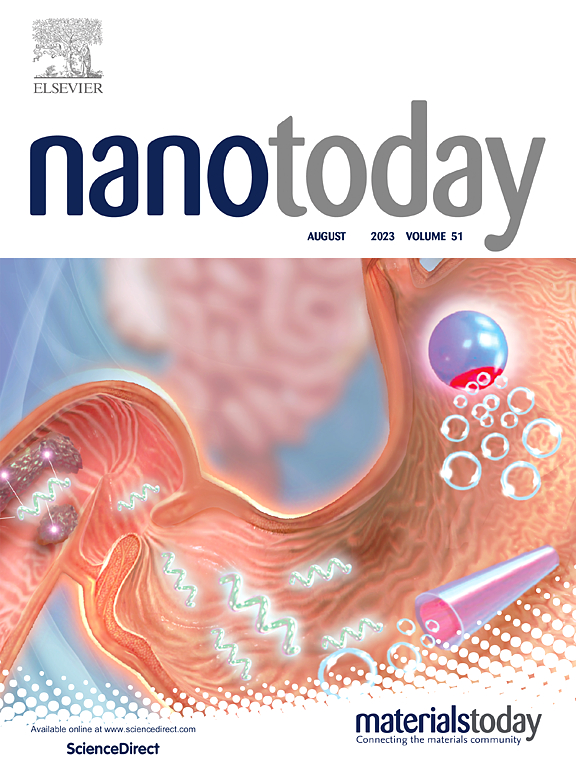A multistage microRNA nanotherapeutic to address fibrosis of bacterial keratitis
IF 10.9
1区 材料科学
Q1 CHEMISTRY, MULTIDISCIPLINARY
引用次数: 0
Abstract
Bacterial keratitis (BK) is a leading cause of visual impairment and blindness. The conventional treatment involves frequent instillation of antibiotics at the lesion site. However, this approach not only leads to bacterial resistance but also suffers from poor bioavailability and often overlooks the damage caused by secondary scarring following corneal infections. In this study, we have developed a multistage nanotherapeutic (DHA-lys@miRNA) to address both anti-infection and secondary scarring hyperplasia during the treatment of bacterial keratitis. Specifically, docosahexaenoic acid (DHA) and ε-polylysine (ε-PL) were successfully self-assembled to form an amphipathic cationic nanocarrier, DHA-lys, which can complex with microRNA to form nanotherapeutics. This nanosystem exhibits potent bacteriostatic effects and amphiphilicity, enabling it to bind to the tear film lipid layer and conjunctival mucosal layer, thereby significantly enhancing its residence time and penetration in the corneal tissue. This, in turn, improves the bioavailability of the drug in bacterial keratitis. Furthermore, we have identified miR-361–3p as a key microRNA through database screening and a series of experiments. This microRNA can specifically inhibit corneal fibrosis by interrupting the crosstalk between corneal stromal cells and myofibroblasts in a BK mouse model in vivo. Overall, this study offers innovative insights into the treatment of infectious eye diseases, leveraging the potential of nucleic acid nanotherapeutics.

一种多阶段microRNA纳米疗法治疗细菌性角膜炎纤维化
细菌性角膜炎(BK)是视力损害和失明的主要原因。常规治疗包括在病变部位频繁滴注抗生素。然而,这种方法不仅会导致细菌耐药性,而且生物利用度差,并且经常忽略角膜感染后继发瘢痕造成的损害。在这项研究中,我们开发了一种多阶段纳米疗法(DHA-lys@miRNA),以解决细菌性角膜炎治疗过程中的抗感染和继发性瘢痕增生问题。具体而言,二十二碳六烯酸(DHA)和ε-聚赖氨酸(ε-PL)成功自组装形成两亲性阳离子纳米载体DHA-lys,该载体可与microRNA络合形成纳米治疗药物。该纳米系统具有强大的抑菌作用和两亲性,使其能够与泪膜脂质层和结膜粘膜层结合,从而显著延长其在角膜组织中的停留时间和渗透时间。这反过来又提高了药物在细菌性角膜炎中的生物利用度。此外,我们通过数据库筛选和一系列实验确定了miR-361-3p是关键的microRNA。在BK小鼠体内模型中,该microRNA可通过阻断角膜基质细胞和肌成纤维细胞之间的串扰特异性抑制角膜纤维化。总的来说,这项研究为感染性眼病的治疗提供了创新的见解,充分利用了核酸纳米疗法的潜力。
本文章由计算机程序翻译,如有差异,请以英文原文为准。
求助全文
约1分钟内获得全文
求助全文
来源期刊

Nano Today
工程技术-材料科学:综合
CiteScore
21.50
自引率
3.40%
发文量
305
审稿时长
40 days
期刊介绍:
Nano Today is a journal dedicated to publishing influential and innovative work in the field of nanoscience and technology. It covers a wide range of subject areas including biomaterials, materials chemistry, materials science, chemistry, bioengineering, biochemistry, genetics and molecular biology, engineering, and nanotechnology. The journal considers articles that inform readers about the latest research, breakthroughs, and topical issues in these fields. It provides comprehensive coverage through a mixture of peer-reviewed articles, research news, and information on key developments. Nano Today is abstracted and indexed in Science Citation Index, Ei Compendex, Embase, Scopus, and INSPEC.
 求助内容:
求助内容: 应助结果提醒方式:
应助结果提醒方式:


